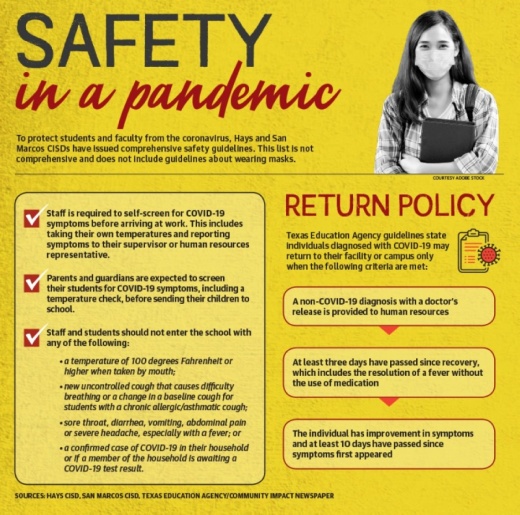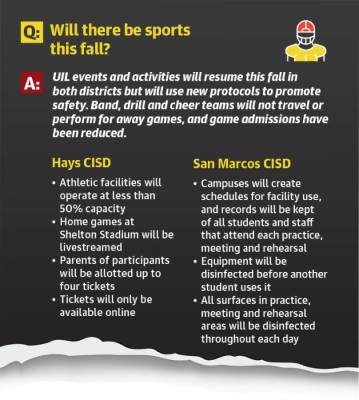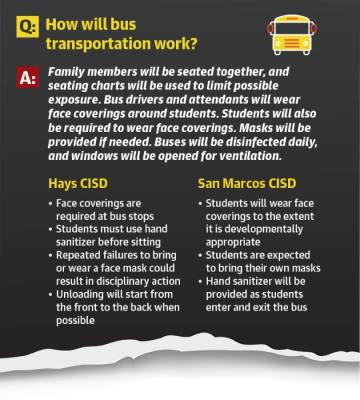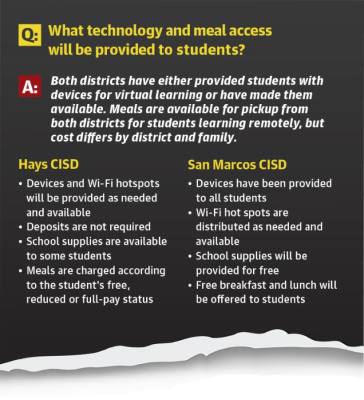Fall semesters began for the campuses within San Marcos CISD and Hays CISD on Sept. 8, as both districts contended with the reality that administrators, teachers and students were swimming in uncharted waters due to the COVID-19 pandemic.
Both districts initially planned to start with three weeks of virtual learning for all students with the option to extend it to four weeks at the discretion of superintendents. That strategy included the potential for an additional four weeks of virtual learning with the approval of their respective school boards and the Texas Education Agency.
But before the semester began, SMCISD elected to extend its first three weeks of virtual learning for its 7,800 students to the full four weeks with an option to extend that another four weeks after Oct. 5, with board approval. Otherwise, on Oct. 5, 40% of students will return for in-person lessons.
“I don’t have a certain percentage or a threshold for me to feel safe, and maybe it’s just a general gut [feeling] and what the schools are doing to helpwith social distancing,” said Suzanne Putegnat on gauging whether it is safe for her two children to return to in-person classes in SMCISD.
For HCISD, about 45% of its 20,169 students are slated to return to campuses Sept. 28.
Tim Savoy, HCISD’s chief communication officer, said Superintendent Eric Wright would have to make the decision of whether HCISD would add a fourth week to virtual learning by Sept. 21 and would need a decision from the board by Sept. 28 to extend it to eight weeks.
In HCISD, roughly 10.3% of the student body began participating in socially distanced virtual learning on school campuses, and the differences between each district’s strategy for the pandemic do have contrasts.
SMCISD has predetermined responses to scenarios, such as students and teachers becoming infected with the coronavirus, allowing the district to quickly react to situations as they arise.
Whether that strategy will be flexible enough to meet the challenges of the coronavirus pandemic is a matter of debate, and Wright said his district is taking a different track.
“I’m not a big believer in a one-size-fits-all [approach],” Wright said. “We handle things on a case-by-case basis because there are too many variables to consider.”
HCISD will navigate scenarios created by the pandemic with a more tailored response and will roll with the punches, according to Savoy.
“That’s the whole problem with the virus. ... There is so much uncertainty and so many different variables that it’s just hard,” Savoy said. “You do the best you can with the information you have at any given time.”
The new normal on campus
Schools will soon reopen for partial in-person instruction, or state mandates assert they could face drastic cuts to their state funding, which represents 19.7% of SMCISD’s funding and 41.2% of HCISD’s budget.
Those were the cards dealt to school districts across Texas over the summer by the TEA and Gov. Greg Abbott.
Both districts have put a positive spin on students returning to campus, and there are benefits, such as increased socialization and student-teacher engagement, according to Wright.
However, there is also an increased risk of infection to every student and employee stepping into schools, according to guidance from the Centers for Disease Control and Prevention.
Under the preferred learning model, parents of students at both HCISD and SMCISD will decide for each grading period whether their children will attend class on campus or virtually for the next nine-week period.
For the first nine-week grading period, about 40% of SMCISD students and 50% of HCISD students will return to schools across Hays County, according to each district.
Parents of children returning to in-person classes in both districts will be asked to sign a form acknowledging their commitment to screening their kids for a fever every day before the student arrives on campus.
However, officials at HCISD were already publicly raising questions about how reliable parents might be in this regard.
“This might be because you’re more positive than I am by nature, but I do have doubt that our parents are going to take care of that for us,” said HCISD District 4 trustee Merideth Keller to Wright at an Aug. 24 board meeting.
Additionally, students of all ages in both districts will be required to wear an approved face covering before being allowed on campus.
Mask exemptions for medical reasons are available, although they require a parent and physician to sign off, according to district information. In HCISD, campus committees will have the final say, according to Macie Walker, the district’s student health services director.
As the pandemic has developed, so have new ways to misbehave and corresponding methods of discipline.
In-school suspension and other traditional punishments will continue to be an option for disruptive students or individuals who break mask protocols. If the envelope is pushed far enough, students may find themselves learning from home, said Jeri Skrocki, HCISD’s director of safety and security.
“We do have the option to make in-school students become virtual students if we find that they can’t comply with the rules and regulations of the campus mandate regarding masks and things like that,” Skrocki said. “But that is ultimately not our first option. That’s our last resort.”
What is more, Skrocki said, students intentionally coughing or spitting on other students or otherwise implying they are infecting others with the coronavirus could catch a legal case.
“In the event that it becomes a more serious matter—someone is COVID-19-positive and they’ve been [purposefully] exposed to somebody—we would also be working with our law-enforcement partners to conduct an investigation,” Skrocki said. “At that point, those cases would be referred to the district attorney’s office for potential prosecution at that level.”
On the brighter side of campus life
While there are hurdles to in-person education during the pandemic, officials say there will also be a number of benefits. Chief among those perks are greater socialization and better engagement with lessons.
“There’s a reason why we have in-person learning, and that’s for the training of soft skills and for the social and emotional [interactions], and just because it’s a better environment for a lot of kids than what they currently face on a day-to-day basis,” Wright said. “We have nice facilities; we have air conditioning; we have running water; we have great internet connectivity—and we have great people which care for them—and we provide two meals a day.”
The plans for both districts state virtual learners will also have opportunities for socialization, and meals will continue to be provided for pickup at both districts.
“We are going to tie in some social-emotional learning during the day so that kids have an opportunity to have peer interaction,” Savoy said of virtual learners. “We’ll do breakout groups, and the teachers will build relationships with their students as always.”
But, as Wright noted, it does not meet the same standard as face-to-face interactions.
With regard to extracurricular activities and planning, both districts are moving forward with various programs.
Andrew Fernandez, SMCISD’s executive director of communications and community relations, said after-school programs such as the YMCA at HCISD and the Sunset After School Program at SMCISD will take some of the burden off parents and further promote socialization.
“It’s been our after-school program with San Marcos CISD for the past few years, and our families really enjoyed the program,” Fernandez said. “We’ve spoken with [district families] to ensure that the safety protocols we, as a district, are implementing, they will be following as well.”
On top of the after-school programs, UIL activities that include a range of sports seasons are still scheduled to resume this semester.
“We will start having volleyball, cross country and football, although the format will be different,” Wright said. “Football, for example—we will have less than 50% capacity at the stadium, and we provide social distancing of 6 feet around each of the spectators.”
School bands, cheer programs and other activities will also resume, according to information from both districts. Because visiting teams cannot bring their bands and other entertainers with them, halftime performances will be focused on the home team’s entertainers.
elebrations are still not happening this semester, but both districts are still exploring alternatives to those seminal school events.
“Our campuses are getting very creative,” Fernandez said. “Some campuses are hosting parades and driving through their campus neighborhoods to welcome our students back.”
Virtual or in-person, the semester will be a new experience for all involved, and Savoy said he is optimistic that the novelty of the situation will unite students and educators.
“This is unknown and uncharted territory, and we’re all going to navigate it together,” he said. “We’re going to be OK and get through it together.”









